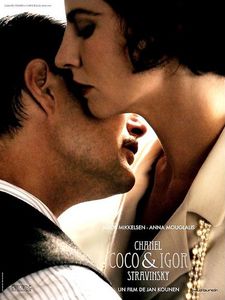 From the opening sequence of Coco Chanel and Igor Stravinsky, it is clear that the film’s focus is style. An elaborate weave of colors and textures create a kaleidoscope that slowly morphs into the action of the film. Well dressed Parisians float through beautiful spaces in a glamorous Opera Hall waiting for the 1913 presentation of Stravinsky’s music. The tension builds as the camera follows dancers, musicians, choreographers and composers who frantically try to keep the angry audience at bay. Throughout this chaotic scene, Coco Chanel (played by Anna Mouglalis) remains calm and poised, her expression flinching only when she meets the firm and volatile Igor Stravinsky (Mads Mikkelsen).
From the opening sequence of Coco Chanel and Igor Stravinsky, it is clear that the film’s focus is style. An elaborate weave of colors and textures create a kaleidoscope that slowly morphs into the action of the film. Well dressed Parisians float through beautiful spaces in a glamorous Opera Hall waiting for the 1913 presentation of Stravinsky’s music. The tension builds as the camera follows dancers, musicians, choreographers and composers who frantically try to keep the angry audience at bay. Throughout this chaotic scene, Coco Chanel (played by Anna Mouglalis) remains calm and poised, her expression flinching only when she meets the firm and volatile Igor Stravinsky (Mads Mikkelsen).
The film examines the relationship that develops between the two artists as the both work to create their respective masterpieces. It starts with their meeting in 1913 and continues through the twenties. The previews emphasize the intensity of their encounters, but this passion is slow to build, coming through glances and pauses. When the two characters finally recognize their connection, it seems somehow sudden and long overdue. Like the rest of the movie, the sex shown beautifully, even when the motivations and consequences are less than commendable. This duality is acheived because the characters both display a detachment from the rest of the world. Chanel’s face is constantly piercing, her eyes in slight squint that demands something from the people she chooses to engage. It works for parts of the film, making her later tears all the more surprising, but doesn’t go so far as to carry the entire film. Neither Stravinsky nor Chanel is portrayed kindly.
The movie features a fashion designer and never lets you forget it. The clothes are crisp, characterizing each of the actors. The colors are given then taken away. The majority of the interactions take place in Chanel’s home allowing the design to be so precise and evolving, it’s almost overwhelming. The camerawork also changes over the course of the film. At first, steady moves dominate. Dramatic and controlled crane shots circle the angry mob in the Paris Opera house. Slow push in on the characters who seem detached from the action around them. As the two characters begin to fall apart, the camerawork becomes more erratic, favoring jerky handheld shots and faster cuts between them. It is clear that the filmmaker has a great appreciation for the music, and lets it paint the emotion in sweeping passionate strokes.
The climax of Coco Chanel & Igor Stravinsky seems anti-climactic. The most important things have already happened when the film is telling you to be most excited. The ending, like the sex, seems sudden, but also overdue. The movie is on the longer side, and has an air of finality about it without feeling complete.
-Kenice Mobley
Coco Chanel & Igor Stravinsky directed by Jan Kounen and staring Mads Mikkelson, Anna Mouglas, and Yelena Morozova opens in theaters nationwide Friday, June 25.